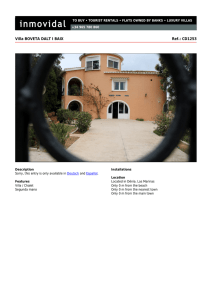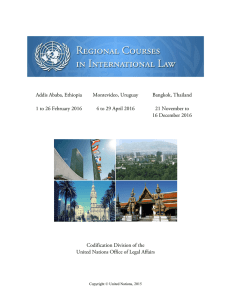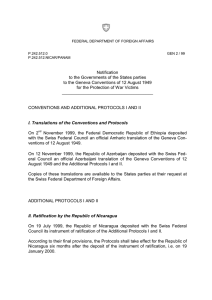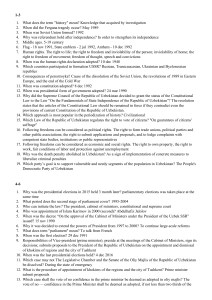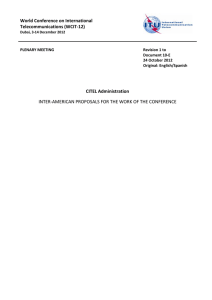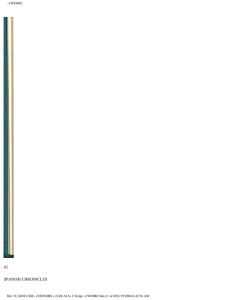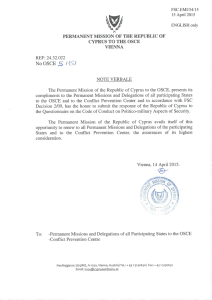Manuel Ælvarez Tardà o and Roberto Villa Garcà a, El precio de la
Anuncio
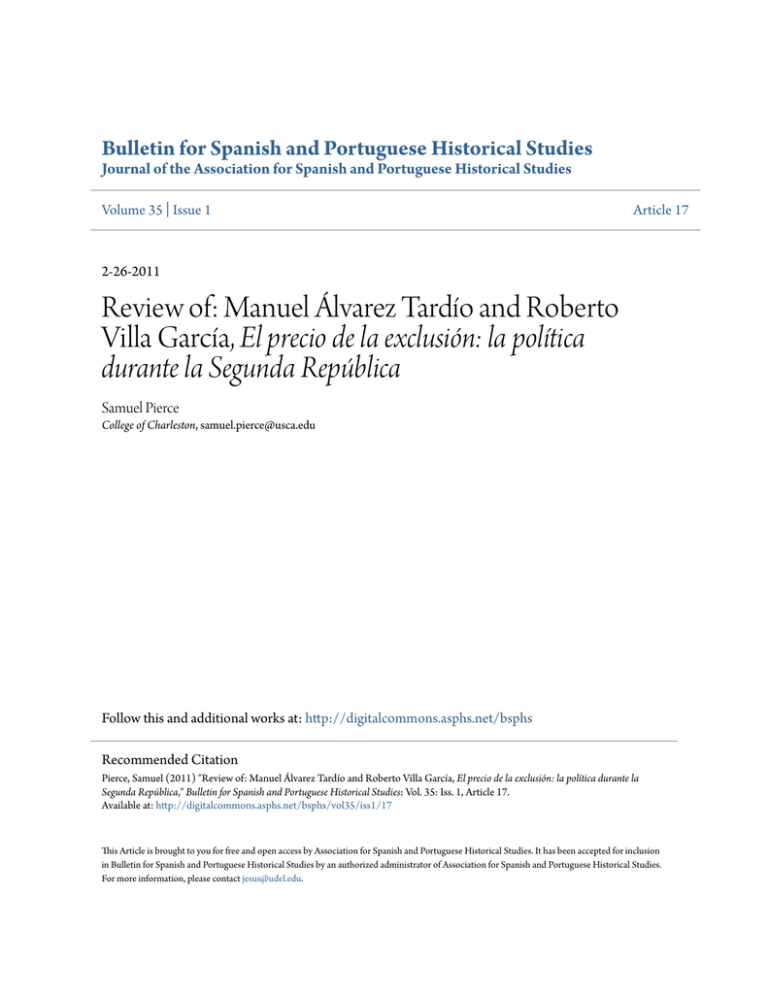
Bulletin for Spanish and Portuguese Historical Studies Journal of the Association for Spanish and Portuguese Historical Studies Volume 35 | Issue 1 Article 17 2-26-2011 Review of: Manuel Álvarez Tardío and Roberto Villa García, El precio de la exclusión: la política durante la Segunda República Samuel Pierce College of Charleston, samuel.pierce@usca.edu Follow this and additional works at: http://digitalcommons.asphs.net/bsphs Recommended Citation Pierce, Samuel (2011) "Review of: Manuel Álvarez Tardío and Roberto Villa García, El precio de la exclusión: la política durante la Segunda República," Bulletin for Spanish and Portuguese Historical Studies: Vol. 35: Iss. 1, Article 17. Available at: http://digitalcommons.asphs.net/bsphs/vol35/iss1/17 This Article is brought to you for free and open access by Association for Spanish and Portuguese Historical Studies. It has been accepted for inclusion in Bulletin for Spanish and Portuguese Historical Studies by an authorized administrator of Association for Spanish and Portuguese Historical Studies. For more information, please contact jesus@udel.edu. BULLETIN FOR SPANISH AND PORTUGUESE HISTORICAL STUDIES 35:1/December 2010/177-178 Álvarez Tardío, Manuel and Roberto Villa García. El precio de la exclusión: la política durante la Segunda República. Madrid: Ediciones Encuentro, 2010. 319 pp. In El precio de la exclusión, Manuel Alvarez Tardío and Roberto Villa García, have taken on the task of explaining why the Second Republic failed. Many historians have approached this topic before, trying to understand why the Republic, which began with great promise, failed to create a lasting democratic system. Alvarez Tardío and Villa García believe that the Republic failed largely because its organizers wanted to exclude political rivals, and they built a political system specifically to help them meet this goal. The authors believe that this was a driving force behind many of the ruling coalition’s projects during the first years of the Republic and that those efforts, not the right’s attempts to undermine it, ultimately destablized Spain’s democracy. This study is part of a revisionist effort to focus more blame on the left for the Republic’s failure, the most notable example of which is Pío Moa. However, Alvarez Tardío and Villa García take a much more subtle analytical approach, focusing on three major problems that they believe the Republicans created when they organized the Republic’s political system. These were the marginalization of moderate Republicans from the governing coalition, an electoral system that privileged large coalitions and punished independent parties, and the establishment of a presidency too strong for parliament to easily work around it and too weak to adequately challenge the Cortes. The authors are especially concerned with the left Republicans’ tendency to associate the Republic’s political system with their own ideological program, which caused them to view their political rivals as “subjugated” (12). This effort, dubbed “the exclusion of the moderates” by the authors, led the Republic’s founders to create a majoritybased election system that was designed to favor large coalitions by reserving a certain percentage of seats in each electoral district for the group with the most votes as opposed to parceling out seats according to the percentages actually won. Meanwhile, the Republicans’ fear of too-strong central power led them to create an “authentic ‘system of distrust’ between [government] powers” because they had “a radical distrust toward all personal power” (96). The authors believe that this caused them to oppose a stronger presidency, which would have been able to more adequately balance the potential radicalism of the Cortes. 177 The authors’ discussion of electoral problems is very useful, if slanted against the left Republicans. Alvarez Tardío and Villa García assert that the Left Republicans miscalculated in part because they did not recognize that their own coalition might collapse or believe that the right could mount a serious challenge to their control of the Cortes, both of which happened in 1933. The result was that a relatively minor shift in public opinion led to large shifts within the Cortes in both 1933 and 1936, and their explanation is one of the best available. So is their demonstration of how women’s votes affected the Republic’s elections much less than has often been assumed. Their breakdown of the vote totals clearly shows that the right’s electoral resurgence in November 1933 was not caused by a massive influx of conservative female voters. It was caused by a series of complex changes that radically altered Spain’s political landscape between 1931 and 1933. This defeat forced the left out of power, and when they returned, they were willing to use all means in their power, legal or otherwise. The final chapter of the book analyzes how the left manipulated the electoral results of 1936, trying to eliminate as many conservative from the Cortes as possible. This, the authors explain, was “a sudden reversal of the process of political modernization begun in the last quarter of the nineteenth century” (283). It indicates that the left had lost faith in democratic government and implies that this made the July military uprising inevitable, a very problematic assertion given the large quantity of information available that indicates that the right had already spent months planning its attack on the government. Many of the author’s criticisms of the left are justified by available historical evidence, but the book lacks similarly substantive analysis of the right. This is an unfortunate lacuna because it effectively tells only one side of the story and fails to provide a balanced assessment of the Republic’s problems. Even so, El precio de la exclusión does provide a great deal of insight and contributes greatly to the debate over the collapse of the Second Republic, especially its analysis of the structural defects of the Republic and its detailed breakdown of voting patterns. Samuel Pierce College of Charleston 178

